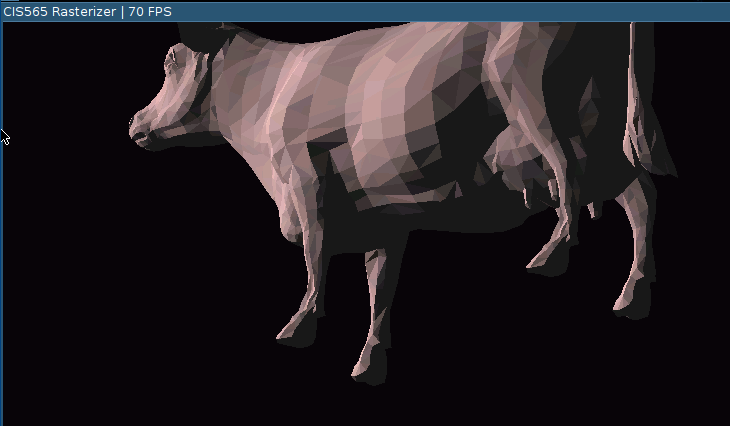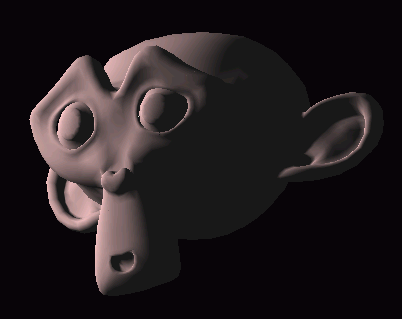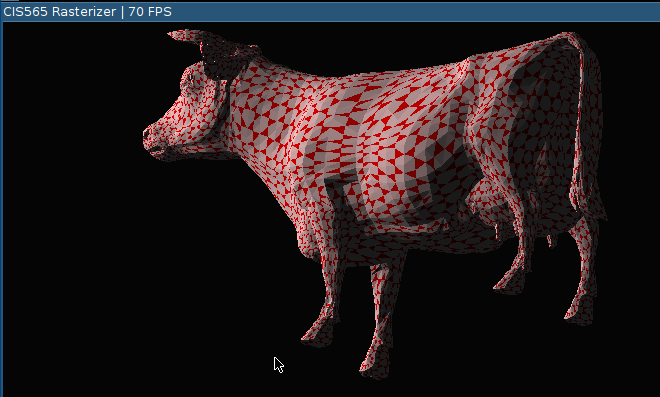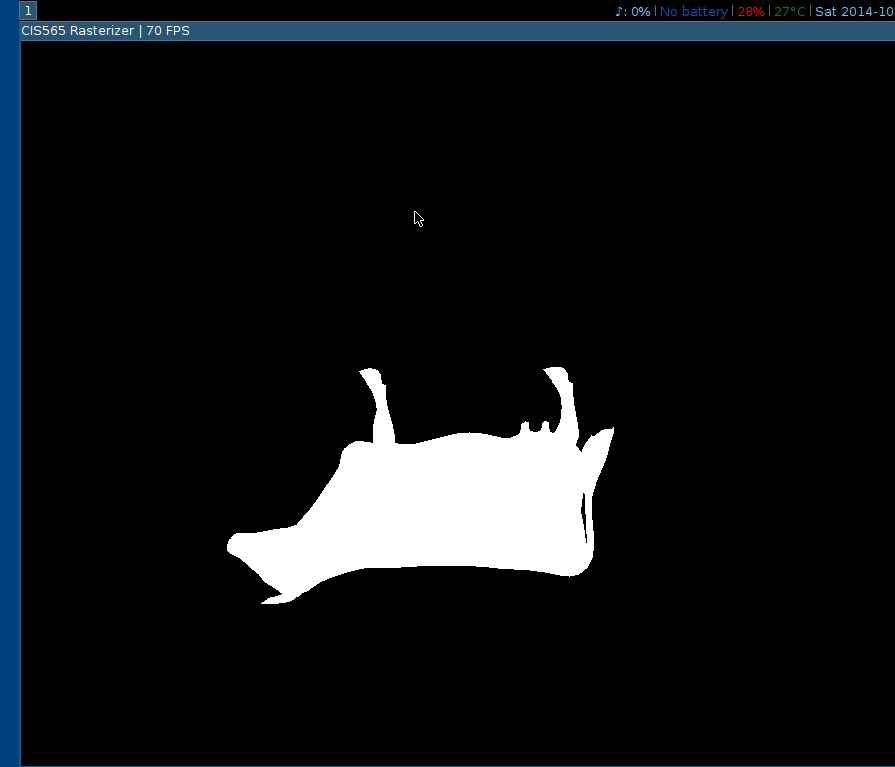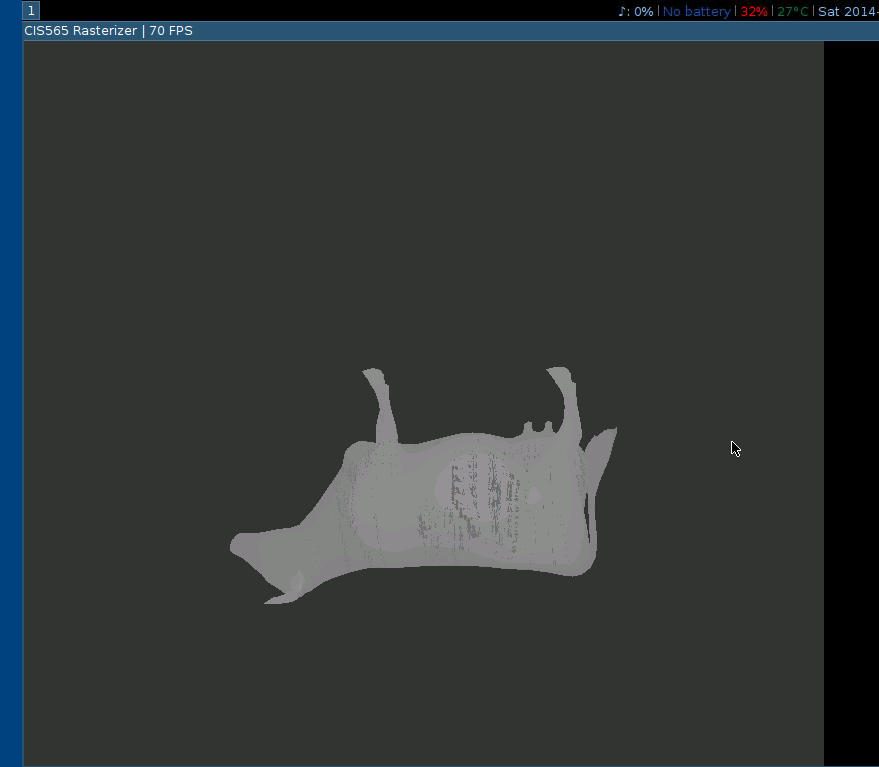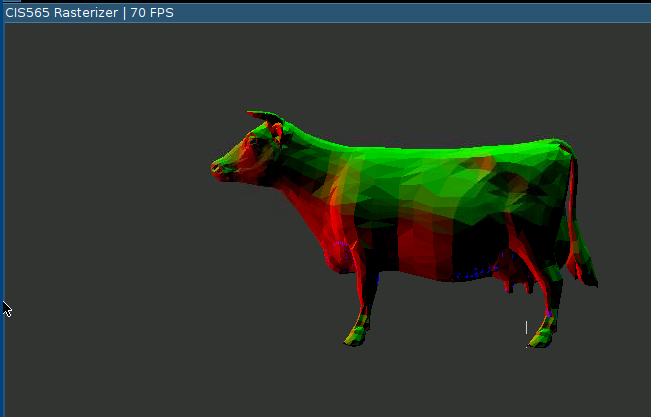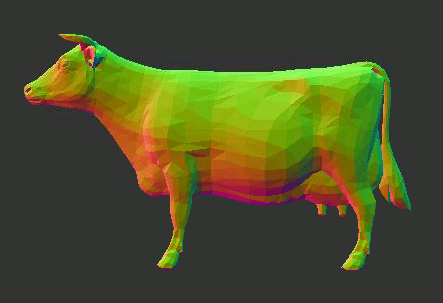- Kai Ninomiya (Arch Linux/Windows 8, Intel i5-4670, GTX 750)
- A library for loading/reading standard Alias/Wavefront .obj format mesh files and converting them to OpenGL style VBOs/IBOs
- A suggested order of kernels with which to implement the graphics pipeline
- Working code for CUDA-GL interop
- Vertex shader
- Model-view-projection transformation
- Primitive Assembly with support for triangle VBOs/IBOs
- Geometry shader
- Maps 1 triangle to 0-4 triangles.
- Backface culling (somewhat more efficient than culling in the rasterization step).
- Basic scanline rasterization into a fragment buffer
- Depth-testing
- Barycentric interpolation of vertex data
- Color: not visible on uncolored model
- Normals: visible with suzanne.obj model
- World-space position: used in lighting calculations
- Using
atomicMinto avoid race conditions in depth testing
- Fragment shading
- Lambert diffuse per-fragment lighting
- Fragment to framebuffer writing
(Extras in bold.)
Diffuse shading:
Diffuse shading showing normal interpolation:
Tessellation in geometry shader:
| Feature | Frame time | Added time | Added time | Notes |
|---|---|---|---|---|
| Nothing | 4.17 ms | Base code. | ||
| Prim asm | 4.22 ms | 0.05 ms | 1.20% | Copying data, handling IBO. |
| Rast+render | 4.77 ms | 0.55 ms | 13.03% | No locking. |
| Normal buffer | 4.84 ms | 0.07 ms | 1.47% | Using normals from mesh. |
| Basic frag shad | 5.80 ms | 0.96 ms | 19.83% | Renders model normals. |
| Backface cull | 5.76 ms | -0.04 ms | -0.69% | 6.13ms using stream compaction to remove backfaces |
| Vert/frag structs | 5.78 ms | 0.02 ms | 0.35% | Performance drop statistically insignificant. |
| World-space pos | 7.21 ms | 1.43 ms | 24.74% | Extra fragment input, extra interpolation of that input. |
| Depth buf optim | 7.13 ms | -0.08 ms | -1.11% | Remove some unnecessary depth checks. |
| VS transforms | 7.77 ms | 0.64 ms | 8.98% | Note that the change in screen size of the model affects the performance. |
| Lambert shading | 8.29 ms | 0.52 ms | 6.69% | |
| GS w/ compaction | 8.82 ms | 0.53 ms | 6.39% | Maximum 4 output tris per input tri. Stream compaction is used after this stage. |
| Tessellation GS | 8.66 ms | -0.16 ms | -1.81% | Splits each tri into 3 tris, colors one red. |
| GS w/ compaction | 9.69 ms | (This series of runs gave overall different results since I did them at a different time.) | ||
| GS w/o compaction | 8.57 ms | -1.12 ms | -11.56% | |
| Tessellation GS | 8.12 ms | -0.45 ms | -5.25% | Tessellation reduces the number of wasted iterations in the rasterization step by decreasing the number of rasterized pixels outside of triangles. |
| Backface GS | 7.91 ms | -0.21 ms | -2.59% | Moved backface culling to inside the GS. This performs a bit better and benefits from the stream compaction already being done for the GS stage. |
Stream compaction seems to be quite costly. With tessellation, only about 1/2 of the triangles would be removed. The performance drop without tessellation is less sharp, since it removes 7/8 of the triangles; but compaction still doesn't improve overall performance.
| With tessellation | Without tessellation | |
|---|---|---|
| Without compaction | 7.91 ms | 9.48 ms |
| With compaction | 9.17 ms | 8.57 ms |
| Tile size | Frame time |
|---|---|
| 16 | 9.50 ms |
| 32 | 9.17 ms |
| 64 | 9.19 ms |
| 128 | 9.27 ms |
Rasterization test:
Depth buffer test (no locks):
Face normals:
Backface culling (reduces flickering due to race conditions):
World-space positions:
